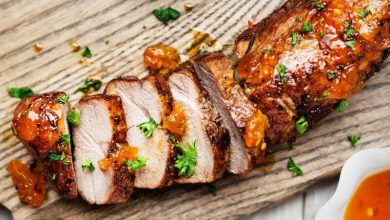🍖 Baby Back Ribs: A Flavorful Delight! 🍖
History 🕰️:
Baby back ribs are a beloved American barbecue classic. They come from the back of the pig, specifically from the upper ribcage area, where the meat is tender, lean, and full of flavor. These succulent ribs have a rich history rooted in the tradition of Southern barbecue.
Components 🥩:
To make delicious baby back ribs, you’ll need:
- Baby back rib rack
- Reynolds Wrap (aluminum foil)
- A flavorful dry rub or marinade of your choice
- Your preferred barbecue sauce
- Optional seasonings, like salt, pepper, and garlic powder
Preparation Steps 🍴:
-
Prep and Seasoning: Start by preparing the ribs. Remove the membrane from the back of the ribs for better tenderness. Apply a dry rub or marinade of your choice, ensuring it covers the ribs evenly. This step adds flavor and helps tenderize the meat.
-
Wrap in Reynolds Wrap: Tear off a piece of Reynolds Wrap aluminum foil long enough to fully wrap the rack of ribs. Place the seasoned rack on the foil, meat side down. Wrap the ribs tightly in the foil, creating a sealed pouch. This will help cook the ribs to perfection and keep them moist.
-
Cooking Time: The cooking time for baby back ribs can vary depending on the method you choose. If you’re using an oven, preheat it to around 275°F (135°C) and bake the wrapped ribs for 2.5 to 3 hours. If you prefer grilling, you can wrap them in foil first, then grill for about 1.5 to 2 hours, turning occasionally.
-
Finish with Barbecue Sauce: Once the ribs are nearly done, open the foil pouch and brush the ribs generously with your favorite barbecue sauce. This step adds a flavorful glaze and caramelization to the meat. You can either continue cooking for another 15-20 minutes or finish on the grill for a few minutes to get that perfect char.
-
Rest and Serve: Let the ribs rest for a few minutes before slicing into individual servings. This allows the juices to redistribute, ensuring a moist and delicious result.
Time ⏲️:
The total cooking time for baby back ribs typically ranges from 2.5 to 3.5 hours, depending on the cooking method and temperature. Slow and low cooking is key to achieving that tender, fall-off-the-bone texture. So, make sure you plan accordingly, as good things take time!
Enjoy your flavorful journey into the world of baby back ribs, and happy eating! 🍖😋🔥
🍽️ Nutrition Facts and Health Information for Baby Back Ribs 🍽️
Nutrition facts can vary slightly based on preparation and serving size, but here’s a general overview for a 3-ounce (85g) serving of cooked baby back ribs:
Calories: Approximately 232 calories
Protein: About 20 grams
Total Fat: Approximately 16 grams
Saturated Fat: Around 6 grams
Cholesterol: Approximately 71 milligrams
Sodium: Approximately 357 milligrams
Carbohydrates: Negligible (less than 1 gram)
Fiber: Negligible (less than 1 gram)
Sugars: Negligible (less than 1 gram)
Health Information 🏥:
-
Protein: Baby back ribs are a good source of protein, which is essential for muscle growth and repair.
-
Total Fat: While they are flavorful, baby back ribs can be relatively high in fat. This can contribute to the richness of the dish but should be consumed in moderation.
-
Saturated Fat: Ribs tend to have a significant amount of saturated fat, which can be associated with an increased risk of heart disease. Limit your intake of foods high in saturated fat.
-
Cholesterol: The cholesterol content is relatively high, so individuals with dietary restrictions or concerns about their cholesterol levels should consume ribs in moderation.
-
Sodium: Barbecue sauces and rubs can be high in sodium, which is something to be mindful of if you’re watching your salt intake.
-
Carbohydrates, Fiber, Sugars: Baby back ribs are very low in carbohydrates, fiber, and sugars, making them a suitable choice for low-carb diets.
It’s important to remember that while baby back ribs are a delicious treat, they are considered an indulgence due to their high fat and calorie content. Enjoying them occasionally as part of a balanced diet is a good approach to maintain a healthy lifestyle. Also, consider alternative cooking methods, such as grilling or smoking, to minimize the use of extra sauces and marinades high in sodium and sugars.



